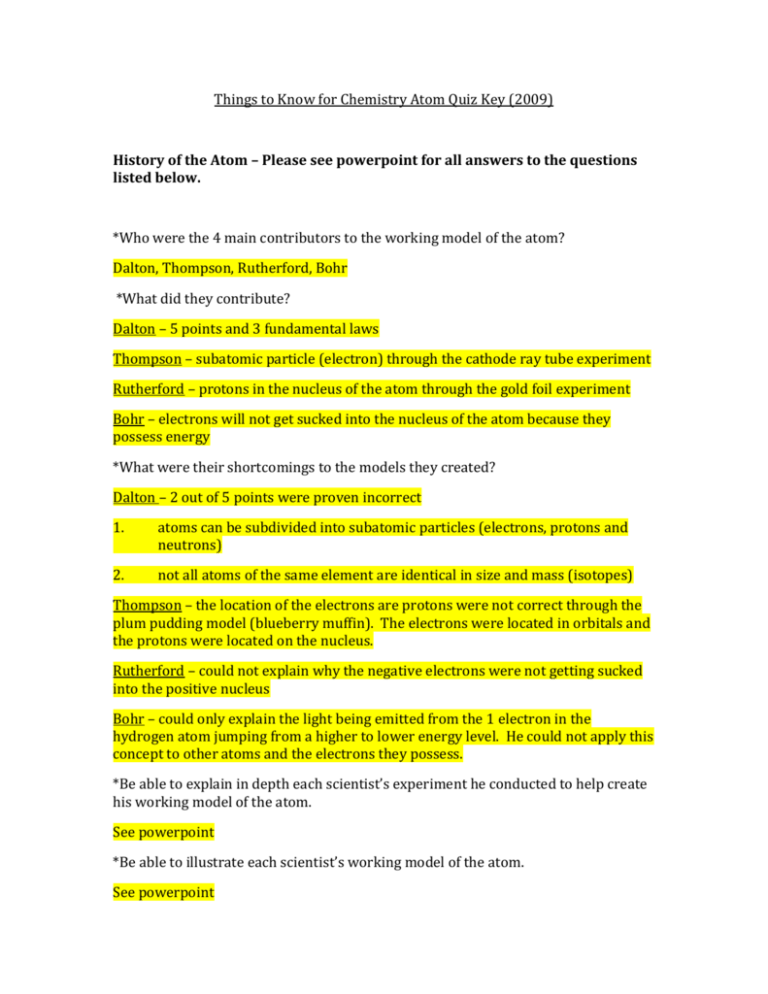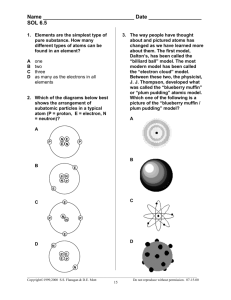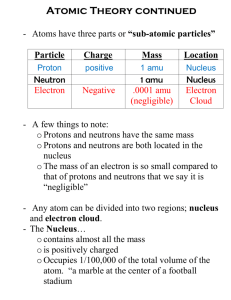Things to Know for Chemistry Atom Quiz Key (2009) History of the
advertisement

Things to Know for Chemistry Atom Quiz Key (2009) History of the Atom – Please see powerpoint for all answers to the questions listed below. *Who were the 4 main contributors to the working model of the atom? Dalton, Thompson, Rutherford, Bohr *What did they contribute? Dalton – 5 points and 3 fundamental laws Thompson – subatomic particle (electron) through the cathode ray tube experiment Rutherford – protons in the nucleus of the atom through the gold foil experiment Bohr – electrons will not get sucked into the nucleus of the atom because they possess energy *What were their shortcomings to the models they created? Dalton – 2 out of 5 points were proven incorrect 1. atoms can be subdivided into subatomic particles (electrons, protons and neutrons) 2. not all atoms of the same element are identical in size and mass (isotopes) Thompson – the location of the electrons are protons were not correct through the plum pudding model (blueberry muffin). The electrons were located in orbitals and the protons were located on the nucleus. Rutherford – could not explain why the negative electrons were not getting sucked into the positive nucleus Bohr – could only explain the light being emitted from the 1 electron in the hydrogen atom jumping from a higher to lower energy level. He could not apply this concept to other atoms and the electrons they possess. *Be able to explain in depth each scientist’s experiment he conducted to help create his working model of the atom. See powerpoint *Be able to illustrate each scientist’s working model of the atom. See powerpoint Atomic Structure- Review powerpoint and all worksheets that were given for homework pertaining to this subject *What is an isotope? An atom of the same element that has a different mass due to the # of neutrons in the nucleus *What is an ion? Charged particle due to the gain or loss of electrons *What is an atom composed of? Be able to explain and draw a picture of an atom and all of its parts. Lots of empty space between the negative electrons located in orbitals and the densely packed positively charged nucleus located on the center of the atom. The nucleus contains positively charged protons and possibly neutrons which do not have a charge. *Know what A and Z symbolize A = mass number (protons + neutrons) Z = atomic number (protons) *Be able to use hyphen notation (Cu-60) and nuclear notation (60Cu) for any isotope *Know how many e-, p+, and n0 are in any isotope or ion given. Complete the following: 15N-3 Pa-186 150 15N-3 p+ = 7 Pa-186 110Ba+2 110Ba+2 n0 = 8 e- = 10 p+ = 91 p+ = 56 Z=80 and A = 150 Z=80 and A = n0 = 95 n0 = 54 p+ = 80 e- = 91 e- = 54 n0 = 70 *How many subatomic particles are in Mn-57? And 40K- ? Mn-57 = 82 e- = 80 40K- = 81 *Which of the following has the same number of neutrons as Ta-150? Os-157 Pb-159 Ir-155 Au-152 *Which of the following has the same number of electrons as 46Ti+2? 42K- 44Ca+ 48Cr+4 Fe-40 *What is the average atomic mass of carbon given the data below? Be sure to show all work, label and use appropriate significant figures based on the relative masses. Isotope Percent Abundance Relative Mass (amu) C-12 98.89% 12.0000 C-13 1.11% 13.0034 = 12.0111 amu *Be able to explain why we see light? Make sure to use the words quantum, photons, ground state and excited state in your answer. When an electron is at ground state, it possesses the minimum energy needed to stay in motion and not get sucked into the nucleus. When electrons absorb photons (packets or particles) carrying energy, they go from ground state to an excited state, father away from the nucleus (sugar high). Eventually, the electrons want to release photons carrying energy in the form of light to feel more comfortable and get closer to the nucleus. Quantum Mechanical Model-Review powerpoint, worksheet and examples done in class What is the orbital notation, electron configuration, and noble gas configuration of Eu? Pb? Ge? K? Sr+2? *For orbital notations, see Mrs. Rustad. 63Eu Electron configuration = 1s22s22p63s23p64s23d104p65s24d105p66s24f7 Noble gas configuration = [Xe]6s24f7 Electron configuration = 82Pb 2 2 1s 2s 2p63s23p64s23d104p65s24d105p66s24f145d106p2 Noble gas configuration = [Xe]6s24f145d106p2 32Ge Electron configuration = 1s22s22p63s23p64s23d104p2 Noble gas configuration = [Ar]4s23d104p2 19K Electron configuration = 1s22s22p63s23p64s1 Noble gas configuration = [Ar]4s1 38Sr+2 Electron configuration = 1s22s22p63s23p64s23d104p6 Noble gas configuration = [Ar]4s23d104p6








